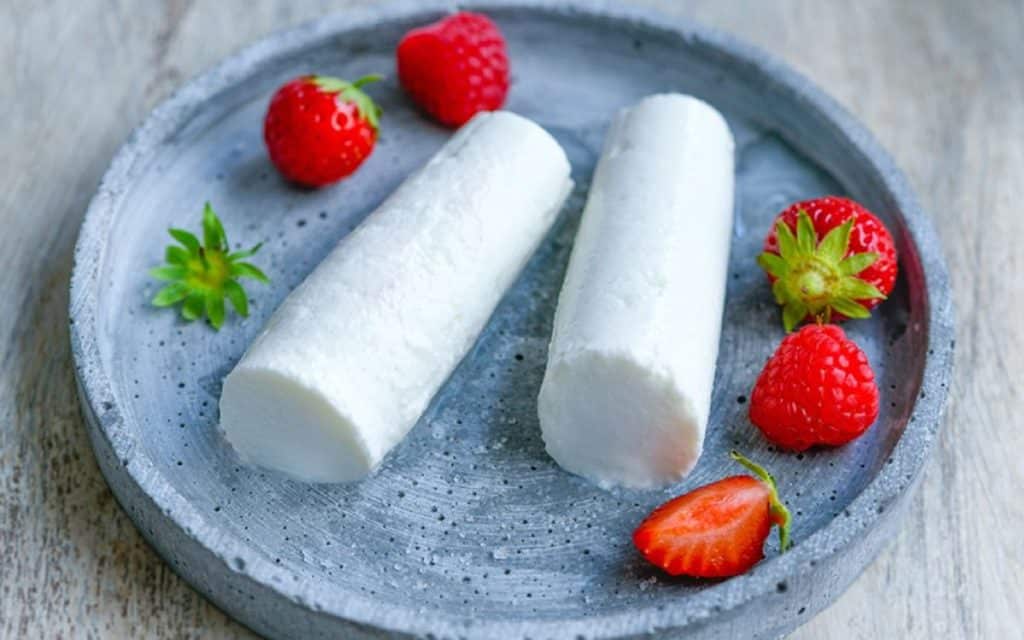What is Brousse du Rove? A Fresh Take on Goat Cheese

Brousse du Rove is more than just a cheese; it’s a testament to the rich culinary heritage of France, a gastronomic gem that bursts with freshness and evokes the rustic charm of Provence. This unique cheese, crafted from the milk of the distinctive Rove goats, offers a fresh take on traditional goat cheese, and its story is as intriguing as its taste.
In this post, we’ll delve into the fascinating world of Brousse du Rove, exploring its origins, production methods, and the sublime flavors that make it a standout in the world of artisanal cheeses.
Quick Facts About Brousse du Rove
| Country of Origin | France |
| Region | Provence-Alpes-Côte d’Azur |
| AOP | 2020 |
| Classification | Soft, creamy, rindless, artisan, rare |
| Milk | Raw Le Rove goat’s milk (sheep’s and cow’s milk) |
| Fat content | 5% to 45% |
| Weight and shape | 1.5 to 1.75 oz (40-50 grams) |
| Size | Diameter: 1.15 to 1.5 inches (3-4 cm); length: 3.5 to 4.75 inches (9-12 cm) |
| No. of Producers | 8 farmhouse producers |
| Best to consume | Within 8 days of production |
| Aroma | Sweet, mild goat milk smell |
| Taste | Refreshing, native flora, tangy, saline |
| Pairing | Omelette, berries, figs, honey |
| Texture | Crumbly white dough with moist & sandy interior |
| Color | White |
What is Brousse du Rove?
Brousse du Rove is an exquisite cheese hailing from the Provence region of France. This unique cheese is made from fresh goat’s milk, specifically from the Rove breed of goats, known for their robust nature and ability to thrive in the Provençal interior. The cheese is a testament to the rich culinary traditions of the region and stands as a symbol of its vibrant gastronomic culture.
The production process of Brousse du Rove is meticulous, contributing to its distinctive characteristics. The cheese is fresh, soft, and creamy, often described as melting in your mouth due to its delicate texture. It is typically sold in cone-shaped plastic containers, retaining its soft, liquidy form. The flavor profile of Brousse du Rove is delightfully mild and sweet, with an underlying hint of the fresh goat’s milk from which it is made.
In 2020, Brousse du Rove earned the prestigious AOC (Appellation d’Origine Contrôlée) status, acknowledging its quality and deep-rooted connection to the specific geographical area of Provence. This status elevates the cheese to a level of international recognition, further solidifying its reputation as one of Provence’s culinary treasures.
Whether you’re savoring it on a slice of bread, pairing it with fruits, or incorporating it into salads and desserts, Brousse du Rove offers a unique taste of Provence. Its freshness, mild flavor, and creamy texture make it a versatile cheese that can be enjoyed in various culinary applications.
Fun fact: Unlike many cheeses that use rennet, Brousse du Rove is obtained from the flocculation (a soft flaking) which makes it the first AOP French cheese that does not use rennet.
What Does Brousse du Rove Taste Like?

Brousse du Rove is known for its unique and fresh taste. The cheese has a mild, delicate flavor that is slightly acidic, but predominantly sweet and milky. Since it’s made from goat’s milk, you can expect a subtle hint of the characteristic tanginess associated with goat cheeses. However, the flavor of Brousse du Rove is not overpowering, making it a perfect choice for those who prefer a milder cheese.
The texture of Brousse du Rove complements its taste beautifully. It’s incredibly soft and creamy, often described as melting in your mouth. This creaminess pairs well with the fresh, light flavor of the cheese, creating a harmonious blend of taste and texture.
It’s important to note that the flavor can slightly vary depending on the diet of the Rove goats whose milk is used to produce the cheese. Factors such as the season and the specific vegetation in the goats’ diet can subtly influence the final taste of the cheese.
Brousse Du Rove Tasting Note
- Flavor Profile: Brousse du Rove has a mild and delicate flavor. It is slightly acidic, but predominantly sweet and milky. The cheese carries a subtle hint of the characteristic tanginess associated with goat cheeses, but it’s not overpowering.
- Texture: The cheese is incredibly soft and creamy. It often melts in your mouth, providing a pleasurable eating experience. The creaminess of the cheese complements its fresh, light flavor.
- Aroma: Brousse du Rove possesses a fresh, goat milk aroma which is quite pleasant and inviting. It embodies the freshness of the Provençal countryside.
- Color: The cheese is typically white, reflecting its fresh and pure goat milk origins.
- Pairings: Due to its mild and versatile flavor, Brousse du Rove pairs well with a variety of foods. It can be enjoyed with bread, fruits, in salads or desserts. It also pairs nicely with light white wines or rosés from Provence.
- Seasonal Variations: The flavor of Brousse du Rove can subtly vary depending on the season and the specific diet of the Rove goats. For instance, cheese produced in the spring, when the goats have access to fresh vegetation, may have a slightly different taste compared to cheese produced at other times of the year.
How Brousse Du Rove is Produced
- Milking: The process starts with milking the Rove goats. These goats are a breed native to the Provence region of France and are known for producing high-quality milk.
- Heat Treatment: The fresh goat’s milk is then heat-treated, typically by pasteurization, to ensure its safety and consistency.
- Curdling: The heat-treated milk is allowed to curdle naturally without the addition of rennet. This is a unique characteristic of Brousse du Rove as most cheeses utilize rennet in the curdling process.
- Draining: The curdled milk is then gently drained to remove whey. This step is crucial in determining the final texture of the cheese.
- Shaping: The drained curd is transferred into cone-shaped molds. This gives Brousse du Rove its distinctive shape.
- Cooling and Maturation: The cheese is then cooled and allowed to mature for a short period. As a fresh cheese, Brousse du Rove does not require a long maturation period.
- Packaging: Finally, the cheese is packaged and ready for distribution. It’s typically sold in cone-shaped plastic containers to maintain its form.
What Pairs Well With Brousse Du Rove
Food that goes well with Brousse Du Rove:
| Category | Food Pairings |
|---|---|
| Sweet Pairings | Provençal honey, purée of fresh berries, fruit preserves, fruit syrup |
| Savory Pairings | Omelette, baked rice, French chicken casserole, Pieds et paquets (mutton/lamb tripes stuffed with lard, garlic, parsley and served with sheep feet) |
| Bread | Served with local bread as part of traditional Provençal cuisine |
| Salads | Can be added to salads for a fresh, creamy element |
| Desserts | Often served as a dessert, drizzled with sweet syrups or paired with fruits |
Beverage that goes well with Brousse Du Rove:
| Category | Beverage Pairings |
|---|---|
| White Wine | Light and crisp wines such as Sauvignon Blanc or a Provençal white wine |
| Rosé Wine | A light, dry rosé from Provence pairs exceptionally well with the mild flavor of Brousse du Rove |
| Red Wine | Light-bodied red wines like a Beaujolais or Pinot Noir could be a good match |
| Non-Alcoholic | Sparkling water or lightly flavored herbal teas can also complement the cheese |
Also read: Best Wine and Cheese Pairings: The Ultimate Guide
The History of Brousse du Rove
Brousse du Rove is a fresh, unsalted cheese that has a rich history dating back about 2,000 years. The cheese is named after the area around Le Rove, a small town near the calanques along the Blue Coast west of Marseille, where it is produced. This region is home to a unique breed of goats called the Rove goats, which thrive in harsh conditions and produce the high-quality milk needed for the cheese.
Historically, Brousse du Rove has always been made from goat’s milk, but over the decades, there have been attempts to use cow’s milk instead. However, a small resistance movement has formed to defend the original Brousse cheese and its traditional methods of production.
The cheese is sold in small conical molds at markets and cheese shops around France, most densely in the Provence region. It is considered a rare cheese due to its specific location and production methods.
In 2007, Brousse du Rove faced a difficult year but rebounded in 2020 when it finally received its Appellation d’Origine Protégée (AOP) status. This designation recognizes the quality, tradition, and geographical origin of the cheese, further cementing its place in French culinary heritage.
The Rove goats, integral to the production of Brousse du Rove, have a long history in Southern France, particularly around Marseille and surrounding areas. They have played a role in sheep pastoralism for centuries.
Today, Brousse du Rove continues to be enjoyed for its fresh and light taste, often paired with Provençal honey and olive oil. Its unique flavor and texture set Brousse du Rove apart from other cheeses, making it a beloved part of French gastronomy.
More Cheeses from France:




